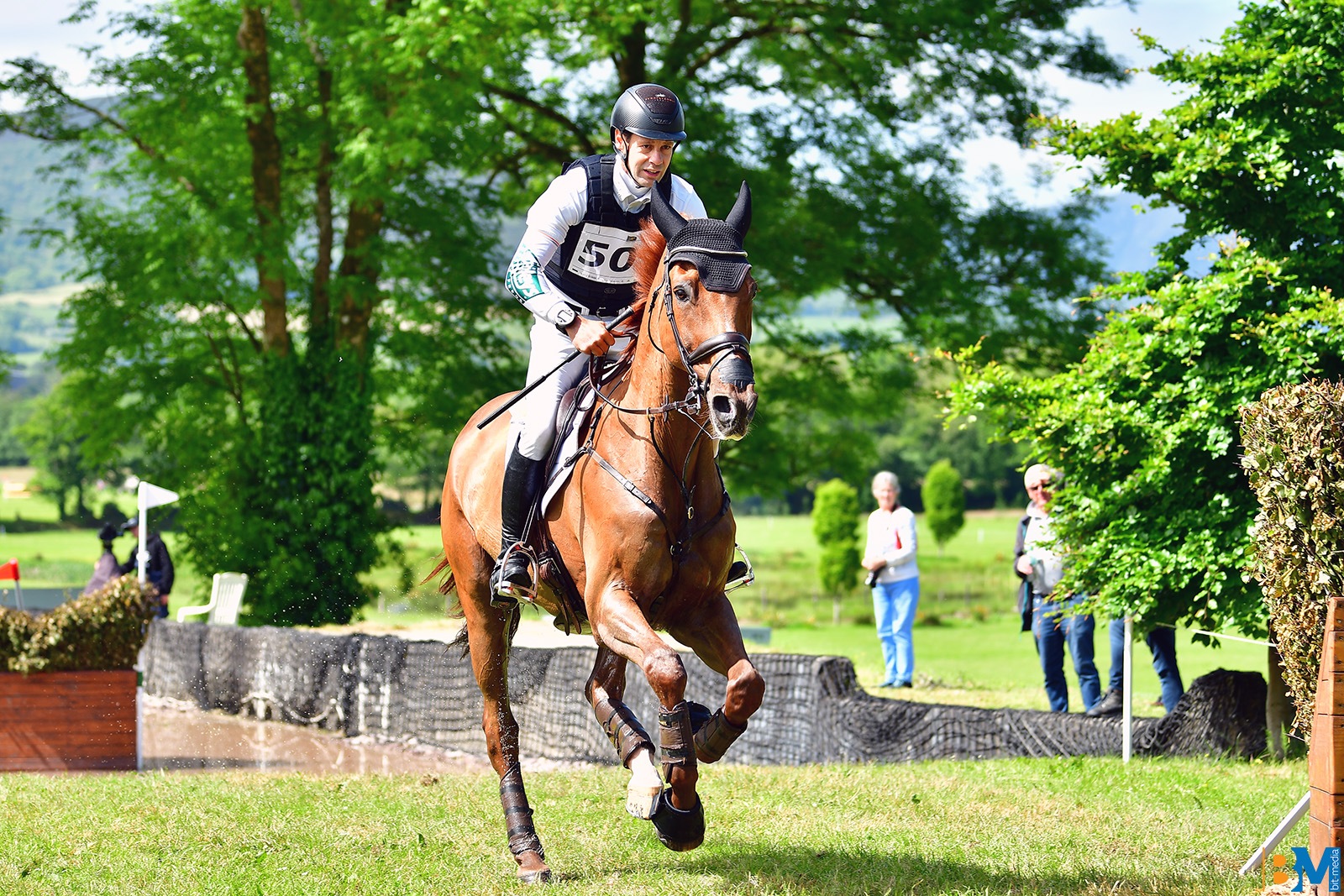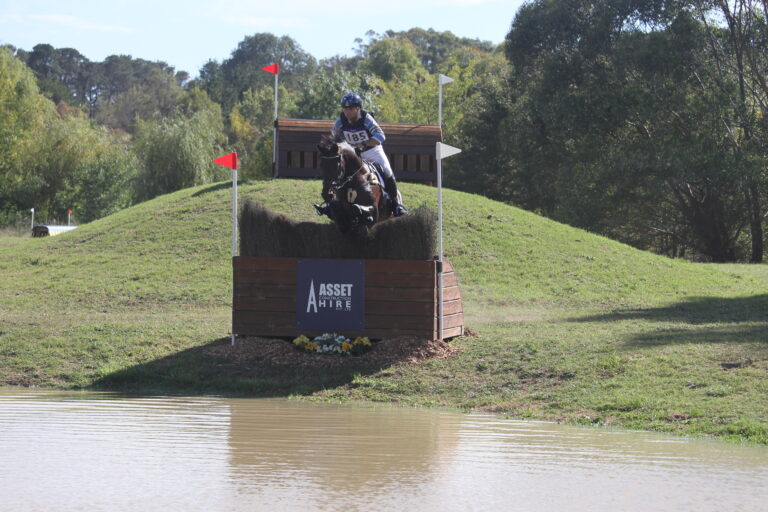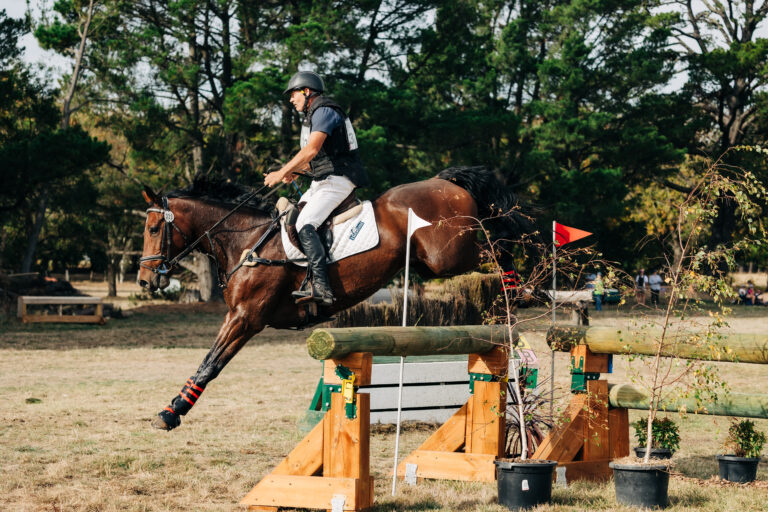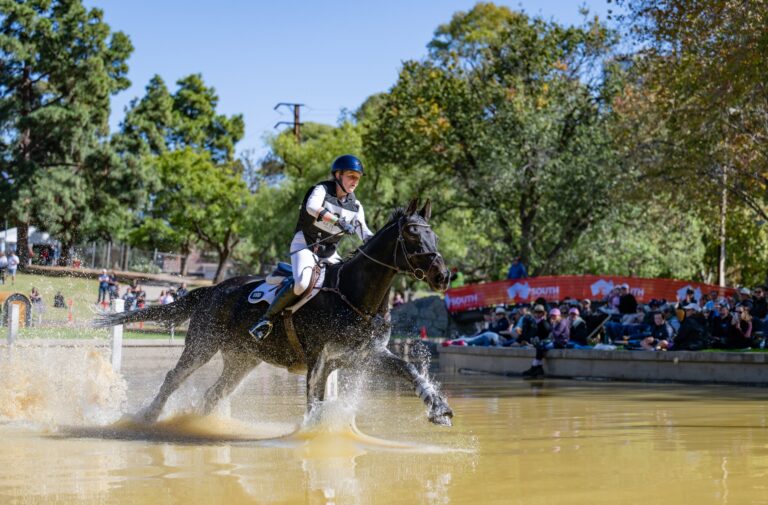Main image: Chris Burton and Shadow Man, by Bit-Media.
Inside Paris | Presented by International Horse Breeders
Dressage done!!! Cross country to come!!!
Sunday, 28 July start time: 6.30pm AEST
6.34pm AEST Shane Rose and Virgil go out the cross country start gates. They are the second combination on course and will have no information on how well or not well the course is riding. Shane and Virgil will go for this cross-country course… like fast, and like right from the start!
Guaranteed there are hidden torpedoes and land mines out there on course, which will become clear as more and more riders take on the course and patterns appear. Patterns being people getting eliminated or incurring refusals or run outs or struggling with concentration levels when the fences just keep coming too quickly. Patterns are defined by competitors becoming guinea pigs, which following competitors can learn from. The big problem is that some of these hidden torpedoes or landmines can be not the norm and just a result of a perfect storm in France with the most beautifully presented fences you have ever seen and a course builder who is trying so so hard to represent a French culture through his cross-country course building. This is not normal. This is very very hard.
The going is wet. Some horses will not perform well in the wet. Yikes. Shane Rose, who just 19 weeks and 3 days ago had a horrendous accident where he broke 18 bones in his body – which included 3 elbow fractures, a clean break in his femur, 4 fractures in his pelvis and 8 broken ribs – is now duty bound to we Australians to gallop 100% fearlessly into this full on war zone, without any prior information other than what has been gleaned from walking the course. Good on you Shane!!
Oh, and something else. We need Shane to go clear cross country and I am sorry, but we need him also to go under time. That is nearly the impossible ask but your country needs it, Shane. Good luck.
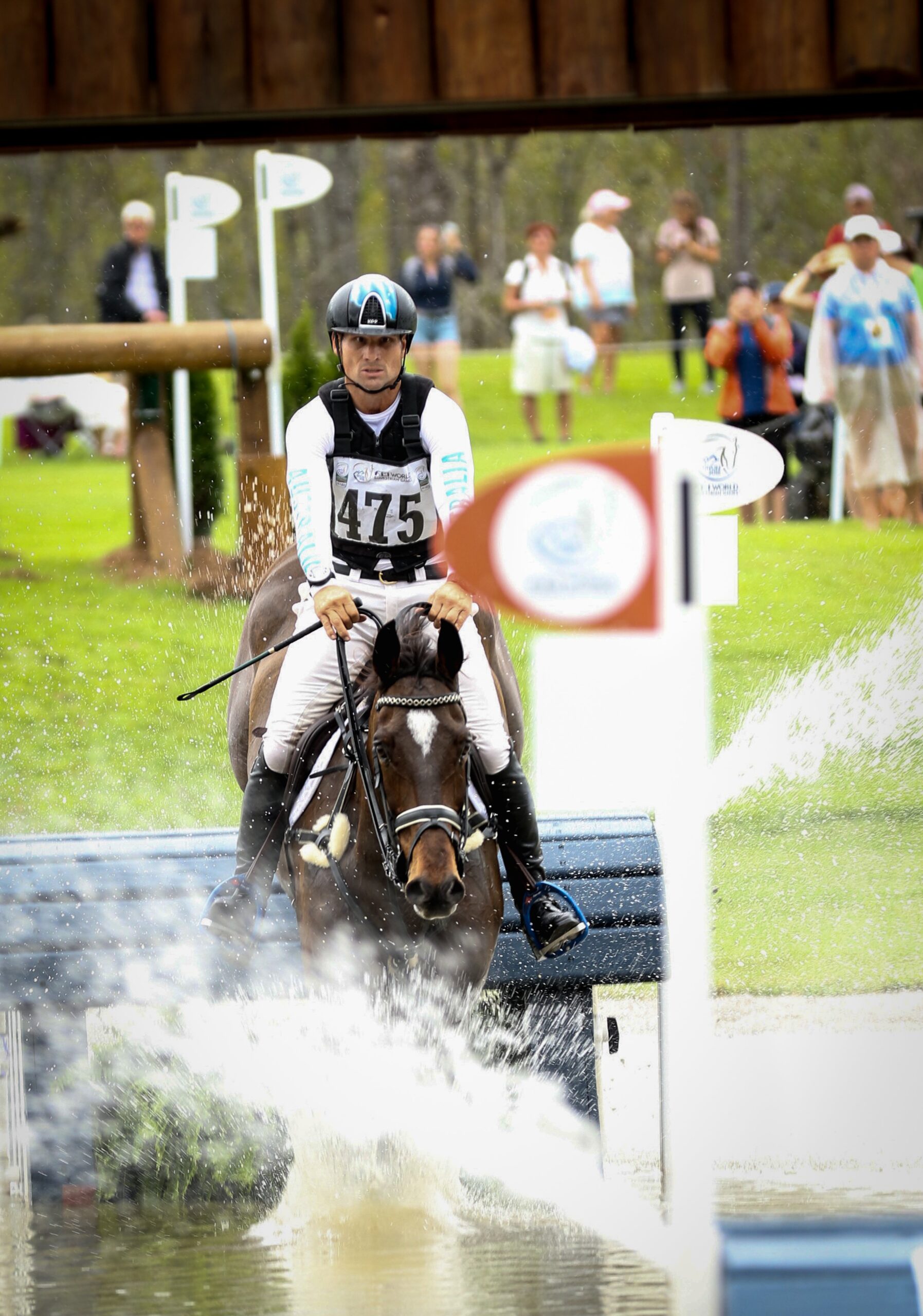
Shane Rose and Virgil. Image by Michelle Terlato Photography.
8.10pm AEST and out we go with Kevin McNab on Don Quidam. Easy Kevin. You will now know what has already happened to about a third of the competitors. It’s not going to be pretty. The cross-country course designer here at the Paris Olympics, is Pierre Le Goupil who is French and who previously designed the cross-country course at the 2023 European Eventing Championships at Haras du Pin, Spain. Out of 53 starters at the European Championships, 27 were clear of cross-country jumping penalties, which equals to 50.9%. So according to this statistic, nearly half the field here tonight, are doomed to stopping, falling or running out. Every second rider in other words, and oh yes just an interesting add on. Only one rider at the 2023 European Eventing Championships made it under time. Oops. Did I forget to mention to Kevin that we needed him to not only go clear but go under time as well? So, who did go under time at Pierre Le Goupil’s last cross-country course. Well trouble for us that’s for sure. It was Ros Canter, who is riding here at these Olympics, and she was on Lordships Graffalo who is her ride this time around again. Ros is currently in sixth position after the dressage and part of the British team which has bolted out into the lead very convincingly. Hey Kevin, we need this British girl, Ros Canter, to be given something to think about. We really, really need you to go under time as well!!
So that part is pretty simple, just giving the first two Australian riders fairly straight forward, uncomplicated instructions on what to do with this Paris cross country course.
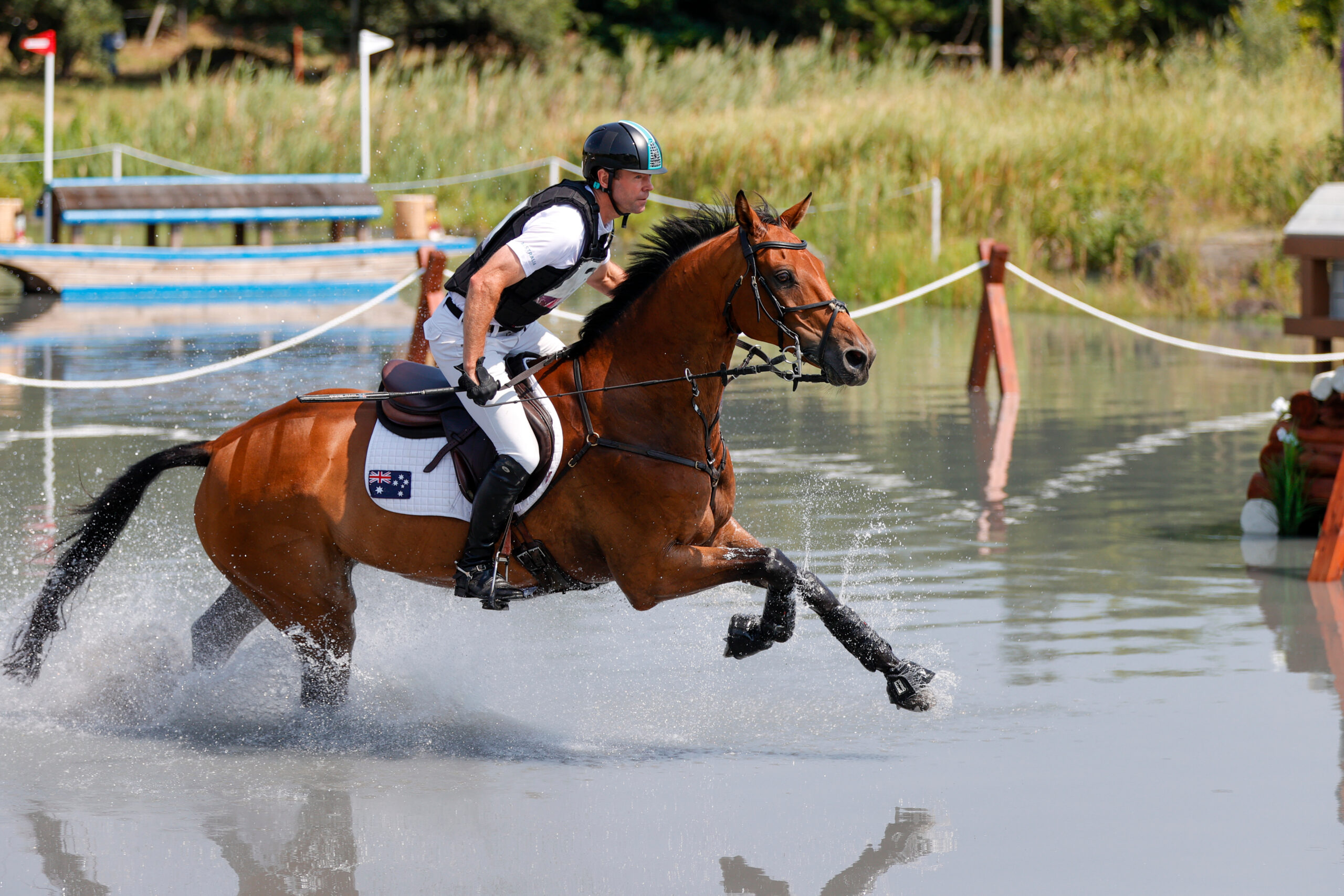
Kevin McNab and Don Quidam. Image by Michelle Terlato Photography.
9.46pm AEST and out we go with Chris Burton and Shadow Man just to bring the whole team home in the best possible medal position. Simple instructions again. Go hard Chris. We need a clear cross-country round, and we need it under time. Ladies and gentlemen just a little statistic for you to mull over, is that Chris Burton himself, is recognised as the fastest cross-country rider in the world today. Chris and Shadow Man are in actual fact a good bet to go clear and under time. Well, when I say, ‘a good bet’, I really mean in normal circumstances. There is nothing normal about what is going to be in front of Chris at 9.46pm tonight. Running number three in a team is a big advantage in terms of having prior knowledge to the hidden torpedos out there and the disguised land mines. Chris will also know where to go hard in the course and were to just maybe bide your time. The downside of running out late in a field is that especially when it is wet, and it is, the going can deteriorate to a point where it is not possible to make the time and also in some instances it could become downright dangerous. Oh, good one. We did sort of forget to flag that! Well never mind Chris, clear cross country and under time, off you go!!
So, you can see everyone, what these three boys and their fantastic horses have in front of them. It is terrifying. Make no mistake however, we have three wonderful Australian riders about to go out there and risk everything in front of the world for us. We all need to stay awake and support them in every way we can.
Some interesting facts about the course
The Paris Olympic cross-country course is 5149 metres in length. A normal CCI4*L cross country course like Sydney CCI4*L t is approximately 5900 metres. The Melbourne CCI4*L cross country course was approximately 5800 metres. So, the Paris Olympic course is 600-700 metres shorter than the three-day event courses here in Australia. Oh, good I can hear you all say. Wait, there is a trap.
The Paris Olympic cross-country course has 45 cross country jumping efforts. The Sydney CCI4*L had 40 jumping efforts. The Melbourne CCI4*L cross country course had 40 jumping efforts. These courses have to be completed averaging 570 metres per minute to not incur time penalties. Soooooo? This means that in Paris the cross-country fences will come up on average every 100 metres. The cross-country fences at Sydney and Melbourne will come up approximately every 145 metres. The kicker appears in the next point.
To jump a cross-country fence mostly the riders will reduce their speeds to around 450 metres per minute. The faster you go over a cross-country fence, the more difficult it is and the more dangerous it is. If you have to reduce your speed from 570 metres per minute to 450 metres per minute, 45 times as opposed to 40 times, it means you have to go much more quickly between the fences. The Paris cross country course is going to be a nightmare statistically and riders will have to go much faster than normal to make the time. As a result of this the speeds between the fences can get up to 690 metres per minute. Around 40km per hour. This ends up getting to be the impossible equation especially when the whole length of the cross-country course is reduced, which it has been in Paris. The shorter course and the more jump obstacles which is what has happened in Paris, makes getting the time almost impossible.
What the riders are going to try and do is catch the cross-country fences as smoothly as possible without reducing the speed back to 450 metres per minute. This makes the course extremely difficult. This makes making time extremely difficult. No time penalties and no jumping penalties however will promise a very high placing and maybe an Olympic medal. What do you do? Ros Canter and Lordships Graffalo can do it!
These cross-country fences are not evenly placed around the cross-country course and so there is one place where there is one cross country fence in a one-minute gallop distance. This is minute three on the cross-country course with fence 11. This is what we call a fast minute. Conversely in the second and the fifth minutes the riders will negotiate seven cross country jumping efforts in just the one minute. This is really tough work. These will be slow minutes. So, you can see that the riders do have a very complicated set of maths which they will have worked out before galloping out of those starting gates.
Jumps to watch
The cross-country course includes two floating pontoons, twice crossing the Grand Canal. Just how this will affect the horses, I have no idea but galloping across floating pontoons will be a very new experience and something I have never come across before. The photos look out of this world.
The menagerie pond (5A, B, C and 6A, B) appears early in the course and although not purportedly big, the horses will be required to jump into the fountain going across the water. This sort of thing can cause chaos with some horses. There are slow options here.
10A, B, C is the second water and is being promoted as the first really big test. There is a seriously angled bridge over a big seriously wide-open ditch. Yuck. The water is jam packed with options and horses may become confused and just drive by! The direct route tackles a big narrow apex on the way out. Lots of super accurate riding needed. The photos look terrifying.
There is a third water called the Royal menagerie at 23 A, B, C, D. The horses could well be tiring here and 23C is a very wide brush in the water turning and angling and so could be quite influential. If you are happy to risk time penalties, there are also lots of options.
The course builder, Pierre Le Goupil, issued a statement which is indicative of a philosophy that is very not normal. Maybe good, but not normal. “In some cases, it won’t be necessarily direct routes versus slow routes, but more like multiple choice questions.” Yeah right. Who does that?
Anyway, this is a supreme test built beyond magnificent and tonight should be the most amazing viewing. Our three boys Shane, Kevin, and Chris, thank you and lots and lots of luck.
Cheers
Heath
